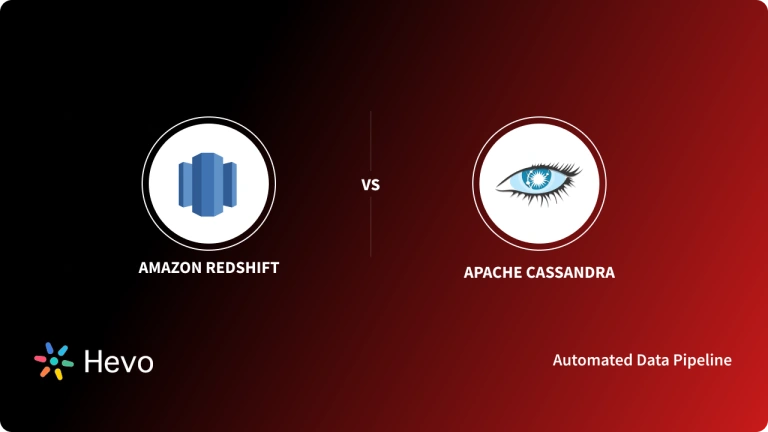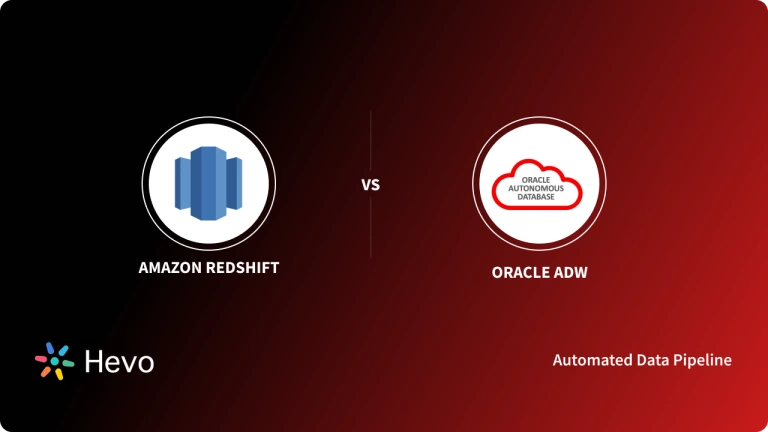More data has been created in the past two years than was ever created in human history. With the exploding volumes of data, people are now looking for data warehouse solutions, which can benefit them in terms of performance, cost, security, and durability. To have an answer to this problem, many companies released data warehousing solutions. Here we will talk about redshift vs druid.
Amazon’s cloud computing platform, Amazon Web Services, launched its Data Warehouse called Amazon Redshift which is an enterprise-level, petabyte-scale, and fully managed Data Warehousing service. Primarily used for Business Intelligence, Druid, on the other hand, is an open-source Data Warehouse designed for queries on both historical and real-time data.
This article will introduce Amazon Redshift and Druid and will shed light on the differences in structure, performance, architecture, and scalability of these two Data Warehouses by comparing them in detail. This will help you decide on the Amazon Redshift Vs Druid discussion and choose the Data Warehouse that is more suitable for fulfilling your needs.
Table of Contents
Introduction to Amazon Redshift
Amazon Redshift is a popular platform that provides Cloud-based Data Warehousing services to businesses. It offers a reliable way to collect and store large amounts of data for analysis and manipulation. Its design consists of a collection of compute nodes which are then organized into a few large groups called clusters. This structure allows it to process data at high speed and offer great scalability to users.
Amazon Redshift is based on a column-oriented architecture and designed to connect to numerous SQL-based clients, business intelligence, and data visualization tools, and make the data available to users in real-time. Based on PostgreSQL 8, Amazon Redshift offers dramatically improved performance and more efficient queries than any other data warehouse. It helps teams make sound business decisions and analyses.
To understand more about Amazon Redshift, visit Redshift’s Official Site.
Take advantage of Redshift’s novel architecture, reliability at scale, and robust feature set by seamlessly connecting it with various tools using Hevo. Hevo’s no-code platform empowers teams to:
- Integrate data from 150+ sources(60+ free sources).
- Simplify data mapping and transformations using features like drag-and-drop.
- Easily migrate different data types like CSV, JSON, etc., with the auto-mapping feature.
Join 2000+ happy customers like Whatfix and Thoughtspot, who’ve streamlined their data operations. See why Hevo is the #1 choice for building modern data stacks.
Get Started with Hevo for FreeIntroduction to Druid
Apache Druid is a well-known Distributed Data Store designed for companies who wish to store large blocks of data. The tool provides the best results in situations like Supply Chain Analysis where real-time collection, lightning-fast queries, and high availability of data are appreciated.
Druid works on a Column-oriented storage format that loads only the columns required for a particular query. Moreover, each of these columns is optimized to meet the specifications for a particular data type.
Using this platform, data is collected in real-time or in batches depending on user specifications. This feature makes Apache Druid a fault-tolerant system where data is protected. Once the information is ingested, a copy is made in deep memory so that in the event of a failure of one of the servers, recovery is easy.
To understand more about Apache Druid, visit here.
Comparing Amazon Redshift vs Druid
| Aspect | Redshift | Druid |
| Deployment | Fully managed on AWS | Self-managed, can be on-prem or cloud |
| SQL Capabilities | Full SQL support | Partial SQL (Druid SQL) |
| Scalability | Scales up by adding nodes, supports petabytes of data | Highly scalable with real-time and historical data capabilities |
| Data Storage | Columnar storage, compressed | Columnar storage, optimized for time-series data |
| Indexing Strategies | Zone maps, compression, no sophisticated indexing | Bitmap indexing, segment-level indexing for fast lookups |
| Real-time Data Ingestion | Batch loading, real-time via external tools like Kinesis | Built for real-time ingestion with near-instant query readiness |
| Data Partitioning | Manual partitioning with distribution and sort keys | Automatic partitioning, especially on time-based dimensions |
| Customers | Nasdaq, Formula 1, Zalando | Adikteev, Airbnb |
Amazon Redshift vs Druid: Detailed Comparison
The following 8 parameters will give you a deep understanding of how the Amazon Redshift Data Warehouse is different from Druid:
- Amazon Redshift vs Druid: Deployment
- Amazon Redshift vs Druid: SQL Compatibility
- Amazon Redshift vs Druid: Scalability
- Amazon Redshift vs Druids: Data Storage
- Amazon Redshift vs Druids: Indexing Strategies
- Amazon Redshift vs Druids: Real-time Data ingestion
- Amazon Redshift vs Druids: Data Partitioning
- Amazon Redshift vs Druids: Customers
Amazon Redshift vs Druid: Deployment
Amazon Redshift being is a fully managed service from AWS makes it easy to get started in a matter of a few steps. Additionally, Amazon Redshift takes the maintenance burden off the user.
Since Druid is open source, setting up is a slightly longer process. You will have to take complete ownership of monitoring and maintaining the deployment.
Amazon Redshift vs Druid: SQL Compatibility
Amazon Redshift is ANSI SQL compatible and works well with Business Intelligence tools.
In contrast, Druid has limited SQL capabilities and the query parser is based on Apache Calcite. As a result, Druid may not seamlessly integrate with your BI tool.
Amazon Redshift vs Druid: Scalability
Both Amazon Redshift and Druid are highly scalable and can easily scale for petabytes of data. Amazon Redshift is a managed service, hence scaling operations are supported out of the box through a UI or a CLI.
Being an open-source database Druid, however, may demand a higher level of maintenance.
Amaozn Redshift vs Druid: Data Storage
Both Amazon Redshift and Druid are columnar databases that result in highly optimized storage, especially in wide-row scenarios.
Amazon Redshift stores individual rows of data whereas Druid maintains measures aggregated on all combinations of dimensions, thereby losing the identity of individual rows of data. This difference makes Redshift a preferred choice when access to individual rows of data is required. However, for OLAP style queries and cubes, Druid gives a better performance
Amazon Redshift vs Druid: Indexing Strategy
Amazon Redshift doesn’t support primary or secondary indexes. It relies on data partitioning, sorting and MPP (Massively Parallel Processing) to speed up query execution.
Druid, on the other hand, relies heavily on indexes to speed up queries.
Amazon Redshift vs Druid: Real-Time Data Ingestion
Druid comes with out-of-the-box support for ingesting streams in real-time through Tranquility or Real-Time Nodes.
Amazon Redshift, on the other hand, does not support stream ingestion. The prescribed method to ingest data into Amazon Redshift is through loading micro-batches using the COPY command. Or, alternatively, you can use a 3rd party tool to bring data from any source into Redshift in real-time.
Amazon Redshift vs Druid: Data Partitioning
In Druid, data is stored in segments that are partitioned by time. Scaling up or down does not require any downtime.
On the other hand, Amazon Redshift partitions data through hashing. When scaling the cluster up or down, data will be re-hashed across the nodes and this will require some downtime.
Amazon Redshift vs Druid: Customers
Both Druid and Amazon Redshift boast a versatile clientele from different industry verticals such as Finance, Healthcare, Media, Technology, etc. Philips, Nasdaq, Pinterest, Amazon, Coursera, Soundcloud are a few customers who have tasted success with Amazon Redshift. Airbnb, Netflix, Appsflyer, Alibaba, are a few businesses that are powered by Druid.
Which Tool To Consider for Your Business?
| Factor | Description | Choose Amazon Redshift | Choose Apache Druid |
| Workload Type | Determines whether you need to process batch or real-time data. | Best for batch analytics on structured data. | Best for real-time and time-series data. |
| Real-time Data Support | Ability to ingest and query real-time data streams. | Limited real-time support. | Built for real-time ingestion and querying. |
| Historical Data Analysis | How well the system handles historical or batch data for analysis. | Excellent for historical batch analytics. | Good for both real-time and historical data. |
| SQL Compatibility | The level of compatibility with SQL standards for querying data. | Full SQL support, including advanced queries. | Partial SQL (Druid SQL), less advanced. |
| Scalability | How well the system scales as data grows, both in storage and query performance. | Horizontally scales with more nodes. | Scales with automatic partitioning and sharding. |
| Data Format | Best suited for the types of data formats used, e.g., structured or unstructured data. | Best for structured relational data. | Best for time-series, logs, and event-based data. |
| Indexing and Query Performance | Performance of the system in terms of indexing and query response times. | Efficient for batch queries with zone maps. | Excellent for fast lookups with bitmap indexing. |
| Ease of Deployment | The complexity of deploying and managing the system. | Fully managed as part of AWS services. | Requires self-management or custom deployment. |
| Integration with Other Tools | Compatibility with other tools and services, particularly for ingestion and data integration. | Best for AWS ecosystem (e.g., S3, Kinesis). | Best for real-time sources (e.g., Kafka). |
| Cost | Total cost of ownership, including scaling, storage, and querying costs. | Higher for large-scale batch processing. Check out Redshift’s Pricing. | More cost-effective for real-time workloads. |
Conclusion
This blog introducedAmazon Redshift and Druid. It further provided the key parameters based on which you can compare Druid and Amazon Redshift and decide which is the more suitable Data Warehouse service for you. In summation, it can be said that both the Data Warehouses have their distinct sets of strengths and weaknesses.
Compare Druid and BigQuery to understand their differences in data processing, scalability, and ideal use cases for analytics. Learn more at Druid vs BigQuery.
Druid would be the right choice if your primary use case is to evaluate time-series data. Given that Druid was developed by an advertising analytics company, it is also specially geared toward analyzing advertising events such as bid requests, impressions, clicks, etc. over time. Druid stores only aggregated data and hence would not be the best choice if you will want to analyze row-level data.
Amazon Redshift, on the other hand, is built to accommodate the slicing and dicing of large data sets. Its strength lies in allowing users to perform complex data joins and aggregations. Amazon Redshift is a managed service and has properties of a traditional relational database that can be used for a wider range of use cases with minimal maintenance overhead.
Sign for a 14-day free trial and experience the feature-rich Hevo suite first hand.
Frequently Asked Questions
1. What is better than redshift?
Alternatives to Redshift, like Snowflake or Google BigQuery, might be better depending on your use case. Snowflake offers easier scalability and separation of compute/storage, while BigQuery provides serverless architecture and automatic scaling.
2. Why is Apache Druid so fast?
Apache Druid is fast due to its real-time ingestion, columnar storage format, distributed architecture, and optimized indexing techniques (e.g., bitmap indexes), which make querying and filtering large datasets highly efficient.
3. When should I use Apache Druid?
Use Apache Druid when you need real-time analytics, fast query performance on large datasets, and support for high-concurrency queries. It’s ideal for time-series data, event-driven applications, and interactive data exploration dashboards.












